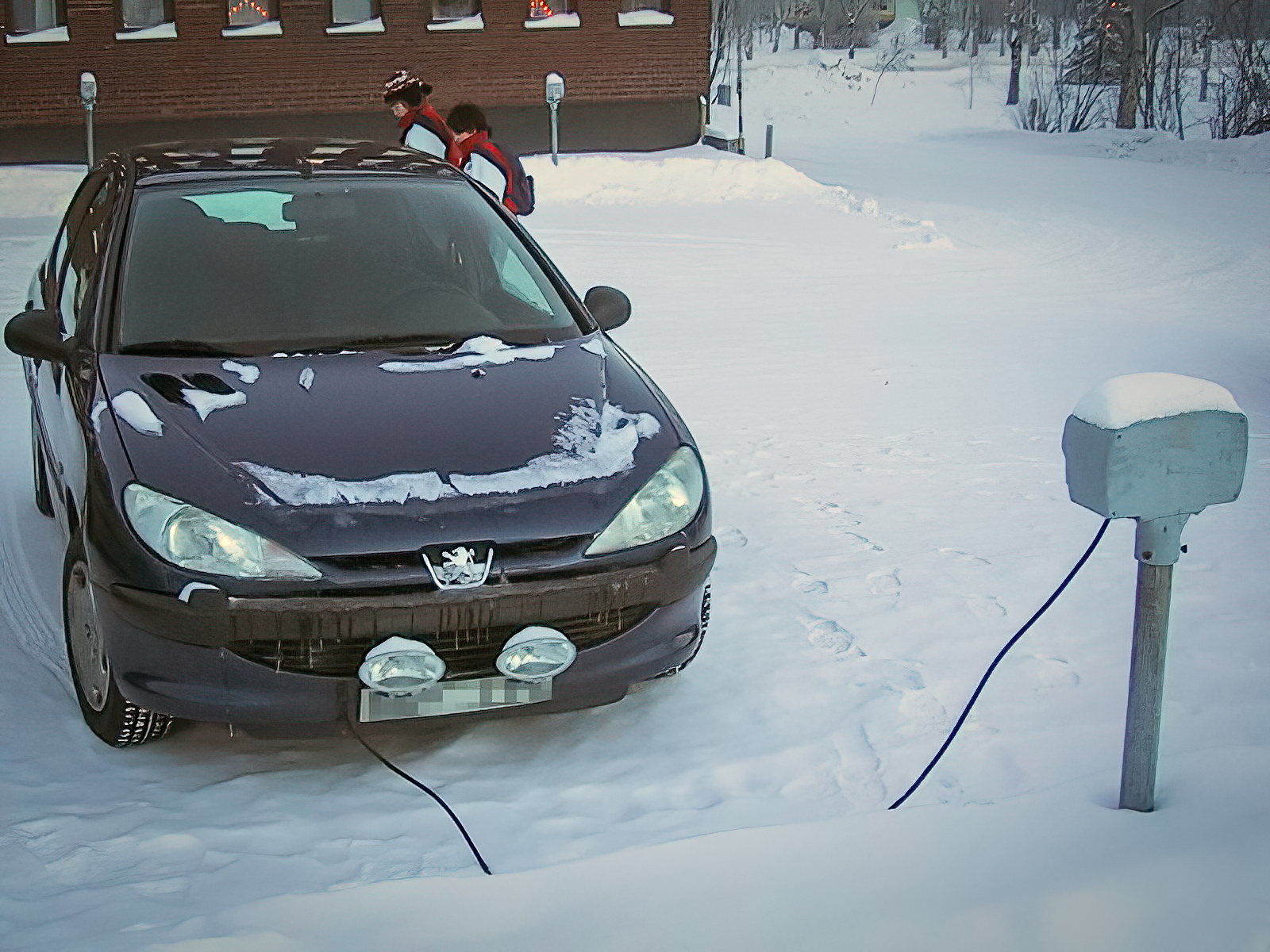|
Engine Block Heater
A block heater is used in cold climates to warm an engine prior to starting. They are mostly used for car engines; however, they have also been used in aircraft engines. The most common design of block heater is an electrical heating element embedded in the engine block. Purpose Pre-heating of an engine is primarily used to make it easier to start. Added benefits are: *The cabin heater produces heat sooner for comfort and to thaw the windscreen. *Reduction of condensation of fuel on cold cylinder walls during start thus ** saving fuel and reducing exhaust emissions and ** reducing oil dilution by gasoline scraped into the oil pan by the piston rings. *The engine reaches operating temperature sooner, so the engine does not run rich as long. This further reduces fuel consumption and emissions. *Less load on the starter and battery thereby prolonging their service lives. *Less engine wear as oil circulation is improved. *Reduces the need for a Remote starter, thereby further ... [...More Info...] [...Related Items...] OR: [Wikipedia] [Google] [Baidu] |
Thermos
A vacuum flask (also known as a Dewar flask, Dewar bottle or thermos) is an thermal insulation, insulating storage vessel that slows the speed at which its contents change in temperature. It greatly lengthens the time over which its contents remain hotter or cooler than the flask's surroundings by trying to be as adiabatic as possible. Invented by James Dewar in 1892, the vacuum flask consists of two wiktionary:flask, flasks, placed one within the other and joined at the neck. The gap between the two flasks is partially evacuated of air, creating a near-vacuum which significantly reduces heat transfer by heat conduction, conduction or convection. When used to hold cold liquids, this also virtually eliminates condensation on the outside of the flask. Vacuum flasks are used domestically to keep contents inside hot or cold for extended periods of time. They are also used for thermal cooking. Vacuum flasks are also used for many purposes in industry. History The vacuum flask ... [...More Info...] [...Related Items...] OR: [Wikipedia] [Google] [Baidu] |
Andrew Freeman (inventor)
Andrew Freeman (March 10, 1909 – January 17, 1996) was an American electrical engineer and the inventor of the electric block heater for automobiles. Andrew L. Freeman was born in Upham, North Dakota. He attended the University of North Dakota in Grand Forks, North Dakota, where he majored in electrical engineering. He served as general manager of Minnkota Power Cooperative from 1940 to 1982. Since 2004, Minnkota Power Cooperative, Inc. has sponsored the Andrew Freeman Design Innovation Competition at the University of North Dakota College of Engineering and Mines. Freeman first developed a block heater around 1947, and received U.S. Patent #2487326 on November 8, 1949. In 1947, Freeman co-founded and served as president of Five Star Manufacturing Company of East Grand Forks, MN to manufacture headbolt heaters. References External links UND Center for Innovation North Dakota Entrepreneur Hall of Fame American electrical engineers University of North Dakota alumni In ... [...More Info...] [...Related Items...] OR: [Wikipedia] [Google] [Baidu] |
Winter Campaign Of 1941–42
Winter is the coldest and darkest season of the year in temperate and polar climates. It occurs after autumn and before spring. The tilt of Earth's axis causes seasons; winter occurs when a hemisphere is oriented away from the Sun. Different cultures define different dates as the start of winter, and some use a definition based on weather. When it is winter in the Northern Hemisphere, it is summer in the Southern Hemisphere, and vice versa. Winter typically brings precipitation that, depending on a region's climate, is mainly rain or snow. The moment of winter solstice is when the Sun's elevation with respect to the North or South Pole is at its most negative value; that is, the Sun is at its farthest below the horizon as measured from the pole. The day on which this occurs has the shortest day and the longest night, with day length increasing and night length decreasing as the season progresses after the solstice. The earliest sunset and latest sunrise dates outside t ... [...More Info...] [...Related Items...] OR: [Wikipedia] [Google] [Baidu] |
Messerschmitt Bf 109
The Messerschmitt Bf 109 is a monoplane fighter aircraft that was designed and initially produced by the Nazi Germany, German aircraft manufacturer Messerschmitt#History, Bayerische Flugzeugwerke (BFW). Together with the Focke-Wulf Fw 190, the Bf 109 formed the backbone of the ''Luftwaffe's'' fighter force during the World War II. It was commonly called the Me 109 by Allied aircrew and some German aces/pilots, even though this was not the official model designation. The Bf 109 was designed by Willy Messerschmitt and Robert Lusser, who worked at BFW during the early to mid-1930s. It was conceived as an interceptor aircraft, interceptor. However, later models were developed to fulfill multiple tasks, serving as Escort fighter, bomber escort, fighter-bomber, day fighter, day-, night fighter, night-, all-weather fighter, ground-attack aircraft, and aerial reconnaissance aircraft. It was one of the most advanced fighters when the fighter first appeared, being furnished with an all-me ... [...More Info...] [...Related Items...] OR: [Wikipedia] [Google] [Baidu] |
Radial Engine
The radial engine is a reciprocating engine, reciprocating type internal combustion engine, internal combustion engine configuration in which the cylinder (engine), cylinders "radiate" outward from a central crankcase like the spokes of a wheel. It resembles a stylized Star polygon, star when viewed from the front, and is called a "star engine" in some other languages. The radial configuration was commonly used for aircraft engines before gas turbine engines became predominant. Engine operation Since the axes of the cylinders are coplanar, the connecting rods cannot all be directly attached to the crankshaft unless mechanically complex forked connecting rods are used, none of which have been successful. Instead, the pistons are connected to the crankshaft with a master-and-articulating-rod assembly. One piston, the uppermost one in the animation, has a master rod with a direct attachment to the crankshaft. The remaining pistons pin their connecting rods' attachments to rings ar ... [...More Info...] [...Related Items...] OR: [Wikipedia] [Google] [Baidu] |
United States Environmental Protection Agency
The Environmental Protection Agency (EPA) is an independent agency of the United States government tasked with environmental protection matters. President Richard Nixon proposed the establishment of EPA on July 9, 1970; it began operation on December 2, 1970, after Nixon signed an executive order. The order establishing the EPA was ratified by committee hearings in the House and Senate. The agency is led by its administrator, who is appointed by the president and approved by the Senate. The current administrator is Lee Zeldin. The EPA is not a Cabinet department, but the administrator is normally given cabinet rank. The EPA has its headquarters in Washington, D.C. There are regional offices for each of the agency's ten regions, as well as 27 laboratories around the country. The agency conducts environmental assessment, research, and education. It has the responsibility of maintaining and enforcing national standards under a variety of environmental laws, in consultat ... [...More Info...] [...Related Items...] OR: [Wikipedia] [Google] [Baidu] |
Dipstick
A dipstick is one of several measurement devices. Some dipsticks are dipped into a liquid to perform a chemical test or to provide a measure of quantity of the liquid. Since the late 20th century, a flatness/levelness measuring device trademarked "Dipstick" has been used to produce concrete and pavement surface profiles and to help establish profile measurement standards in the concrete floor and paving industries. Testing dipstick A testing dipstick is usually made of paper or cardboard and is impregnated with reagents that indicate some feature of the liquid by changing color. In medicine, dipsticks can be used to test for a variety of liquids for the presence of a given substance, known as an analyte. For example, urine dipsticks are used to test urine samples for haemoglobin, nitrite (produced by bacteria in a urinary tract infection), protein, nitrocellulose, glucose and occasionally urobilinogen or ketones. They are usually brightly coloured, and extremely rough to th ... [...More Info...] [...Related Items...] OR: [Wikipedia] [Google] [Baidu] |
Engine Block
In an internal combustion engine, the engine block is the structure that contains the cylinders and other components. The engine block in an early automotive engine consisted of just the cylinder block, to which a separate crankcase was attached. Modern engine blocks typically have the crankcase integrated with the cylinder block as a single component. Engine blocks often also include elements such as coolant passages and oil galleries. The term "cylinder block" is often used interchangeably with "engine block". However, technically, the block of a modern engine (i.e., multiple cylinders integrated with another component) would be classified as a monobloc. __TOC__ Construction The main structure of an engine typically consists of the cylinders, coolant passages, oil galleries, crankcase, and cylinder head(s). The first production engines of the 1880s to 1920s usually used separate components for each element, which were bolted together during engine assembly. Modern en ... [...More Info...] [...Related Items...] OR: [Wikipedia] [Google] [Baidu] |
Oil Pan
An oil is any nonpolar chemical substance that is composed primarily of hydrocarbons and is hydrophobic (does not mix with water) and lipophilic (mixes with other oils). Oils are usually flammable and surface active. Most oils are unsaturated lipids that are liquid at room temperature. The general definition of oil includes classes of chemical compounds that may be otherwise unrelated in structure, properties, and uses. Oils may be animal, vegetable, or petrochemical in origin, and may be volatile or non-volatile. They are used for food (e.g., olive oil), fuel (e.g., heating oil), medical purposes (e.g., mineral oil), lubrication (e.g. motor oil), and the manufacture of many types of paints, plastics, and other materials. Specially prepared oils are used in some religious ceremonies and rituals as purifying agents. Etymology First attested in English 1176, the word ''oil'' comes from Old French ''oile'', from -4; we might wonder whether there's a point at which it' ... [...More Info...] [...Related Items...] OR: [Wikipedia] [Google] [Baidu] |







